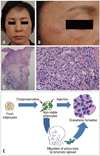To the Editor,
A 57-year-old woman presented with multiple, asymptomatic, variable-sized, erythematous nodules that had been present for the previous two months on both inferior periorbital areas and the perioral area (Fig. 1A and B). She had undergone a session of tattooing on the upper vermilion border and three sessions of autologous fat injection (AFI) into the forehead and both cheeks four years previously. Fresh fat was used during the first session of AFI, and cryopreserved fat was used during the second and the third sessions for retouching at one month intervals. The skin lesions did not completely coincide with injection or with tattooing sites, and she had no injection history of allogeneic fillers or implants.
A skin biopsy was performed on the periorbital area and histopathologic findings revealed a noncaseating granulomatous inflammation around numerous round to oval lipid materials and multiple microcysts in the superficial and deep dermis (Fig. 1C and D). There were no granules of dye and Ziehl-Neelsen and Warthin-Starry staining revealed no organisms. The granulomatous lesions were treated by intralesional injection of triamcinolone and showed partial response.
AFI has several advantages, it is relatively cheap, easy to harvest, available in abundance, and autogenic compared to artificial fillers; thus, it is commonly used for facial rejuvenation.1 AFI is regarded as a relatively safe filler due to the low potential risks, although some severe adverse reactions including acute vision loss and hemiplegia due to fat embolism have been reported.1-3 However, granuloma formation raises a fundamental question about AFI, because autologous cells should not be recognized as foreign eliciting immunologic reactions.
Recently, a few cases of granuloma formation after AFI have been reported, and cryopreservation of fat has been mentioned as a possible cause.3 Freezing is known to damage adipocytes through osmotic stress and intracellular ice formation, and compared with fresh fat, calcification and fibrosis are more frequently associated with frozen fat injection.2,4 In the present case, cryopreserved fat cells were used to recover lost volume and for retouching after the initial injection. Although the foreign body reaction observed in our case could not be proven to have originated from cryopreserved fat, nonviable adipocytes damaged by cryopreservation might have induced foreign body granuloma formation, as the patient clearly denied injection of allogeneic fillers, implants, or any other substance aside from AFI.
Although the skin lesions did not coincide with injection sites, the presence of fat vacuoles in non-injection sites was observed on histopathology, confirming its migration. Interestingly, in previously reported cases, all granulomas appeared in the eyelids, and were mainly explained by local migration and possible lymphatic migration of cryopreserved fat.3 Lymphatic spread of injected silicone has been previously reported,5 and in our case, granulomas in the perioral area were located in the buccinator lymph node area, supporting the possibility of lymphatic spread.
Our case suggests that cryopreserved, nonviable fat vacuoles from forehead and cheek injections might migrate into the periorbital and perioral areas via lymphatic drainage, leading to a granulomatous reaction (Fig. 1E); thus, operators should recognize foreign body granuloma as a possible complication of AFI.
Figures and Tables
Fig. 1
(A and B) Multiple, asymptomatic, variable-sized, lightly erythematous nodules on both inferior periorbital areas and the perioral area. (C and D) Non-caseating granulomatous inflammation around numerous round to oval lipid materials and multiple microcysts in the superficial and deep dermis (C: H&E, original magnification ×40, D: H&E, original magnification ×400). (E) A possible mechanism of granuloma formation after autologous cryopreserved autologous fat injection.

References
1. Locke MB, de Chalain TM. Current practice in autologous fat transplantation: suggested clinical guidelines based on a review of recent literature. Ann Plast Surg. 2008; 60:98–102.
2. Kim SM, Kim YS, Hong JW, Roh TS, Rah DK. An analysis of the experiences of 62 patients with moderate complications after full-face fat injection for augmentation. Plast Reconstr Surg. 2012; 129:1359–1368.

3. Sa HS, Woo KI, Suh YL, Kim YD. Periorbital lipogranuloma: a previously unknown complication of autologous fat injections for facial augmentation. Br J Ophthalmol. 2011; 95:1259–1263.

4. Wolter TP, von Heimburg D, Stoffels I, Groeger A, Pallua N. Cryopreservation of mature human adipocytes: in vitro measurement of viability. Ann Plast Surg. 2005; 55:408–413.




 PDF
PDF ePub
ePub Citation
Citation Print
Print


 XML Download
XML Download